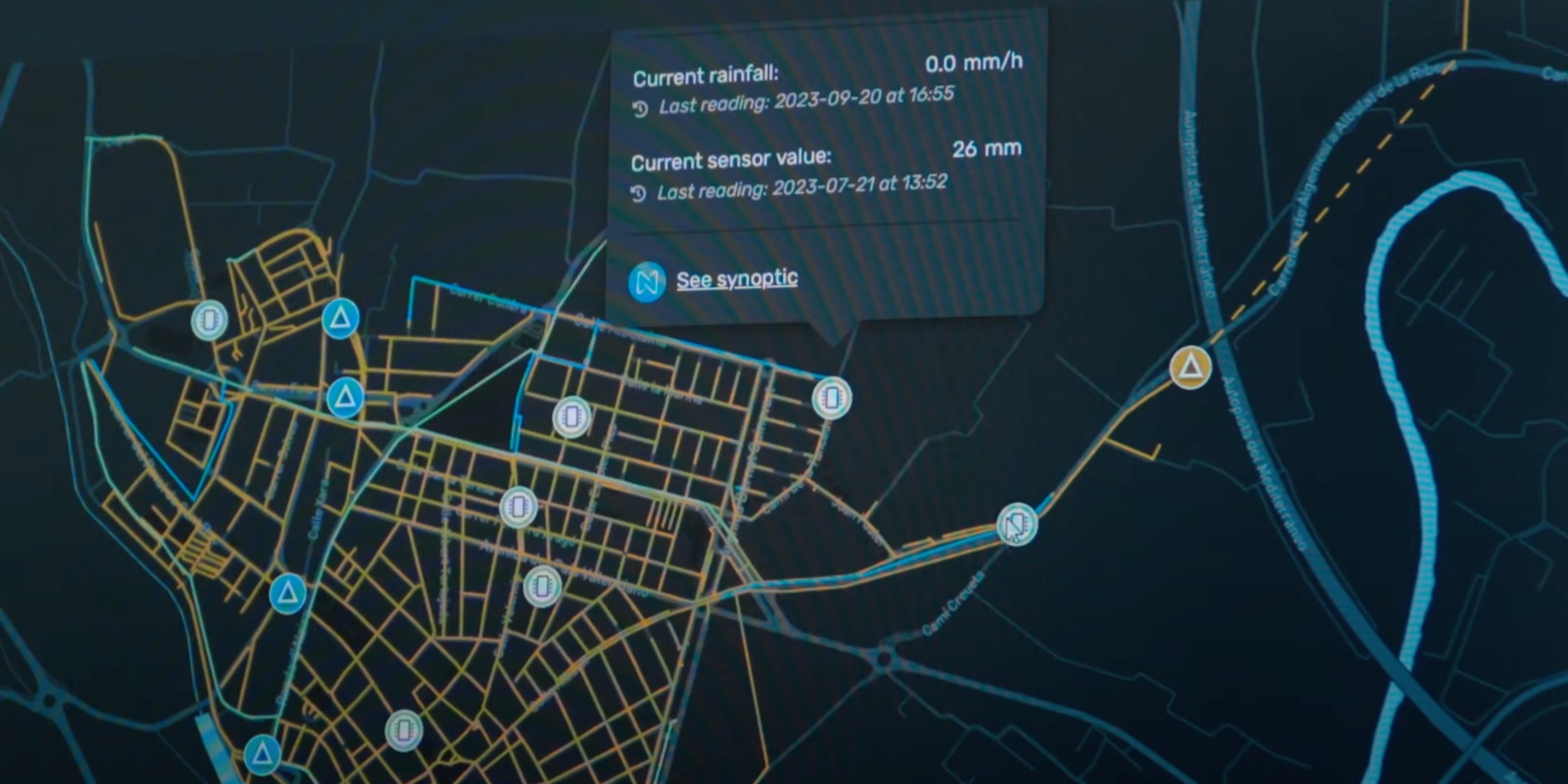Combined sewer overflows: Smarter solutions for water utilities
As extreme weather events like heavy rainfall and flooding become more frequent, combined sewer overflows (CSOs) are putting greater strain on urban water systems. These overflow events not only threaten local ecosystems but also pose public health risks. To meet these growing challenges, utilities need smarter, data-driven approaches to effectively manage and mitigate CSOs.
With Xylem’s innovative solutions, including the Xylem Vue platform, water utilities can optimize their systems, enhance real-time monitoring, and reduce the impact of combined sewer overflows in a world where climate change is rewriting the rules.
What are combined sewer overflows?
Combined sewer overflows (CSOs) occur when a city’s combined sewer system, designed to transport both stormwater and wastewater, becomes overwhelmed during periods of heavy rainfall or snowmelt. When the capacity of the sewer system is exceeded, excess water, containing both untreated sewage and stormwater, is discharged directly into nearby rivers, lakes, or other bodies of water.
Combined sewer overflows can result in environmental pollution, serious public health risks, and violations of regulatory standards. As urban areas grow and experience more extreme weather events, the frequency and severity of CSOs increase, placing significant strain on water utilities tasked with managing these events.

Why are combined sewer overflows difficult to manage?
Managing combined sewer overflows is particularly challenging due to the complexity of aging infrastructure and unpredictable weather patterns.
Many water utilities still rely on legacy combined sewer systems that were not designed to handle the demands of modern urban environments or the intensity of today’s storm events.
Additionally, mitigating combined sewer overflows requires an approach that balances infrastructure upgrades, real-time monitoring, and regulatory compliance – all while operating with limited budgets. Without the right data and tools, water utilities may struggle to accurately predict overflow events or implement timely interventions.
Changing regulations for combined sewer overflows
Regulations surrounding combined sewer overflows (CSOs) are becoming stricter as governments implement stronger environmental protections and compliance with updated water quality standards. In the United States, the EPA continues to enforce the Clean Water Act through revised National Pollutant Discharge Elimination System (NPDES) permits, requiring municipalities to implement long-term control plans to reduce or eliminate CSO discharges.
Meanwhile, Europe is tightening enforcement of the Urban Wastewater Treatment Directive, requiring cities to modernize their infrastructure to limit CSO events. These regulatory changes reflect growing concerns about the environmental impacts of untreated wastewater entering natural water bodies, particularly as extreme weather events become more frequent due to climate change. Water utilities need to adapt quickly to avoid penalties and ensure compliance with these changing regulations.
An evolving approach to managing combined sewer overflows
In the early days of urban infrastructure, cities managed combined sewer overflows (CSOs) with minimal intervention, relying on the natural dilution of wastewater during heavy rain events. However, as populations grew and environmental awareness increased, this approach became a major concern for public health and water quality.

In the mid-20th century, the primary response was to build larger wastewater treatment plants and increase system capacity, but this proved costly and insufficient during extreme weather events.
Over time, the focus shifted to separating stormwater from sewage through sewer separation projects. While effective, these projects required significant investment in new infrastructure and were not feasible for all cities.
Modern solutions for reducing combined sewer overflows
Today, the solutions to manage combined sewer overflows have become more digital. Water utilities are increasingly incorporating real-time monitoring, smart controls, and predictive analytics into their systems to better anticipate and respond to overflow events. Companies like Xylem offer solutions such as Xylem Vue, which uses data to optimize sewer system performance and reduce overflow risks.
Green infrastructure, including rain gardens, permeable pavements, and green roofs, has also become a key tool in managing stormwater at its source, reducing the burden on combined sewer systems.
These modern approaches not only mitigate combined sewer overflows but also enhance the sustainability and resilience of urban water systems in the face of climate change and increasing urbanization.
How Xylem Vue addresses combined sewer overflows
Xylem Vue helps cities manage combined sewer overflows (CSOs) more effectively by using real-time sensors, predictive analytics, and decision support systems to optimize their existing wastewater network. This approach not only improves operational efficiency but also saves significant costs by helping cities avoid investing in potentially disruptive new infrastructure projects. Further, leveraging the data that Xylem Vue provides allows utilities to more easily report to regulators as well as justify capital expenditures.

Xylem Vue’s real-time data and advanced analytics give utility operators visibility into their sewer systems, allowing them to predict CSO events and take preventative action.
In addition, Xylem’s platform supports utilities in running simulations and evaluating the effectiveness of various projects. By continuously monitoring rainfall, system capacity, and sewer performance, Xylem Vue enables more accurate decision-making and helps utilities meet regulatory requirements. Multiple cities have significantly reduced combined sewer overflow volumes and saved millions in infrastructure costs by implementing Xylem Vue.
Richmond, Virginia: Reducing combined sewer overflows with real-time analytics
The City of Richmond, Virginia, faced a significant challenge in managing combined sewer overflows (CSOs), with overflows ranging between one and three billion gallons annually into the James River. To address this, Richmond partnered with Xylem to implement a real-time data and decision support system using the Xylem Vue platform, which integrated data from sensors across the city's sewer network, offering enhanced visibility into rainfall patterns, system capacity, and overflow risks.
By leveraging real-time analytics, Richmond identified infrastructure projects that would make the most significant impact on reducing CSO volumes.

The projects identified are expected to reduce combined sewer overflows by 182 million gallons per year.
The system empowered the city to create a defensible, data-driven plan that complied with regulatory requirements set by the Virginia General Assembly, all while optimizing costs. Additionally, Richmond increased public transparency by providing real-time access to CSO event data, boosting community awareness of effective stormwater management.
Buffalo, New York: Cutting combined sewer overflows with smart sewers
Buffalo, New York, faced nearly two billion gallons of combined sewer overflows annually due to its mid-20th-century sewer system. To avoid a costly $525 million long-term control plan, the Buffalo Sewer Authority partnered with Xylem to implement a Real-Time Control System (RTC) through Xylem Vue. This system enabled the city to optimize its existing sewer infrastructure using predictive analytics and real-time monitoring, drastically reducing the need for new, costly infrastructure projects.
The smart sewer system cut Buffalo’s CSO volume by 450 million gallons in just the first year. The results empowered Buffalo to revise its long-term control plan, saving $145 million while significantly improving the city’s environmental performance.
To date, Buffalo has reduced 3.5 billion gallons of CSO volume. The city has become an international leader in smart water management and this innovative approach has reduced the community’s financial burden.
Cincinnati, Ohio: Saving millions by reducing combined sewer overflows
Cincinnati’s Metropolitan Sewer District (MSD) faced an enormous challenge: reducing 14.4 billion gallons of combined sewer overflows discharged annually into the Ohio River. The city was under a federal consent decree to reduce combined sewer overflow volumes, with an estimated infrastructure upgrade cost of $3.1 billion. Instead of traditional costly solutions, MSD partnered with Xylem to implement a smarter, more cost-effective approach using Xylem Vue powered by GoAigua’s SSO/CSO Prediction and Prevention application.

This real-time decision support system allowed Cincinnati to optimize its existing infrastructure, reducing overflow volumes by 247 million gallons annually.
The innovative solution helped the city avoid over $38 million in capital project costs, cutting CSO mitigation costs to less than $0.01 per gallon.
South Bend, Indiana: Smart technology reduces combined sewer overflows by 80%
The City of South Bend, Indiana, faced the challenge of managing 1-2 billion gallons of combined sewer overflows (CSOs) annually, threatening the St. Joseph River. A federal consent decree in 2012 required South Bend to develop a long-term control plan, initially estimated at $713 million in capital improvements. Given the city’s population size and economic constraints, this plan presented a significant financial burden.
To tackle this issue without resorting to expensive gray infrastructure, South Bend partnered with Xylem to implement a real-time decision support system (RT-DSS) powered by Xylem Vue’s SSO/CSO Prediction and Prevention application.
This smart sewer technology enabled the city to manage wet weather events by optimizing existing sewer capacity. The system, featuring smart sensors and 13 automated gates, allowed operators to control overflow situations in real time, reducing combined sewer overflow volumes by 80% – about one billion gallons annually.
By using data-driven insights to avoid costly infrastructure expansion, the city saved approximately $400 million in capital expenditure and has also benefitted from $1.5 million in annual operational cost savings.
South Bend’s success with Xylem’s system has not only improved environmental outcomes by lowering E.coli concentrations in the river by over 50%, but it has also positioned the city as an innovator in water management.
Learn more about Xylem’s solutions for combined sewer overflows
Xylem Vue helps water utilities reduce combined sewer overflows with intelligence and smart analytics at the network, plant, and asset level.

